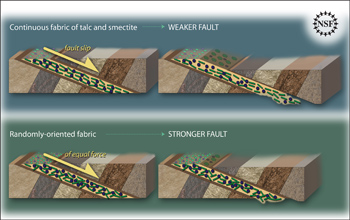Multimedia Gallery
Continuous fabric makes for a weaker fault, while randomly-oriented fabric makes it stronger.
Studies have shown certain low-angle faults to be a lot weaker than expected. The weakness is a result of the structure of the fabric of the fault. When it is composed of fine-grained talc and smectite in a continuous layered architecture, the fault is much weaker than when the fabric is randomly oriented.
Credit: Zina Deretsky, NSF
Images credited to the National Science Foundation, a federal agency, are in the public domain. The images were created by employees of the United States Government as part of their official duties or prepared by contractors as "works for hire" for NSF. You may freely use NSF-credited images and, at your discretion, credit NSF with a "Courtesy: National Science Foundation" notation.
Additional information about general usage can be found in Conditions.
Also Available:
Download the high-resolution JPG version of the image. (637 KB)
Use your mouse to right-click (Mac users may need to Ctrl-click) the link above and choose the option that will save the file or target to your computer.
Related story: It's Not Your Fault--A Typical Fault, Geologically Speaking, That Is



